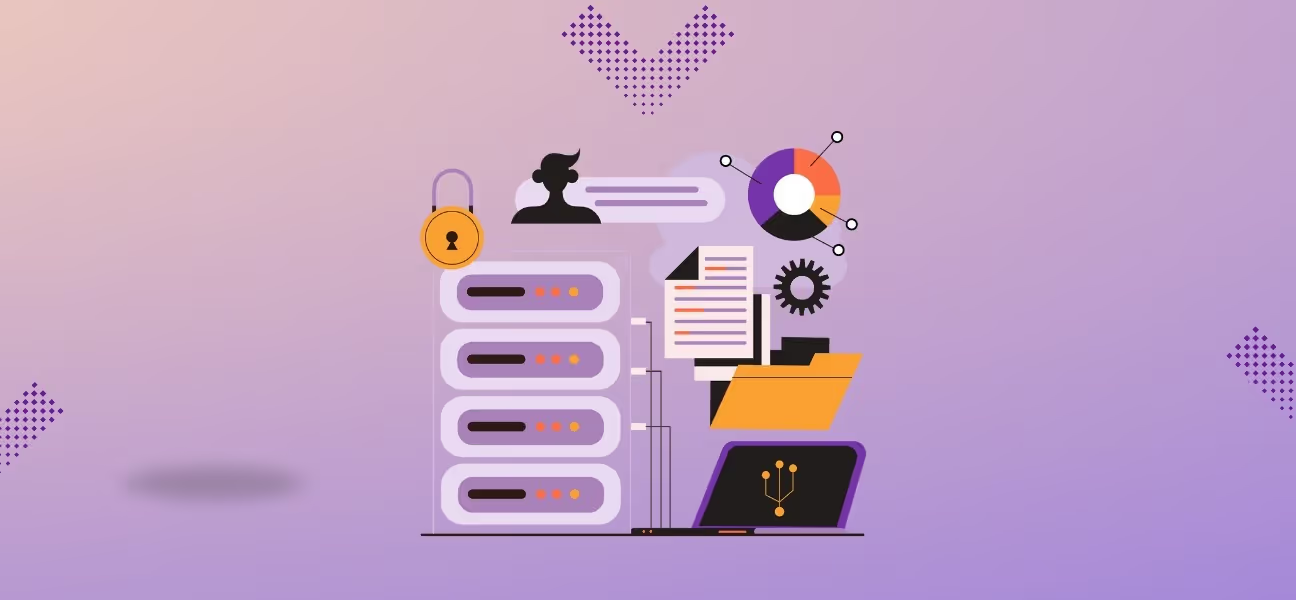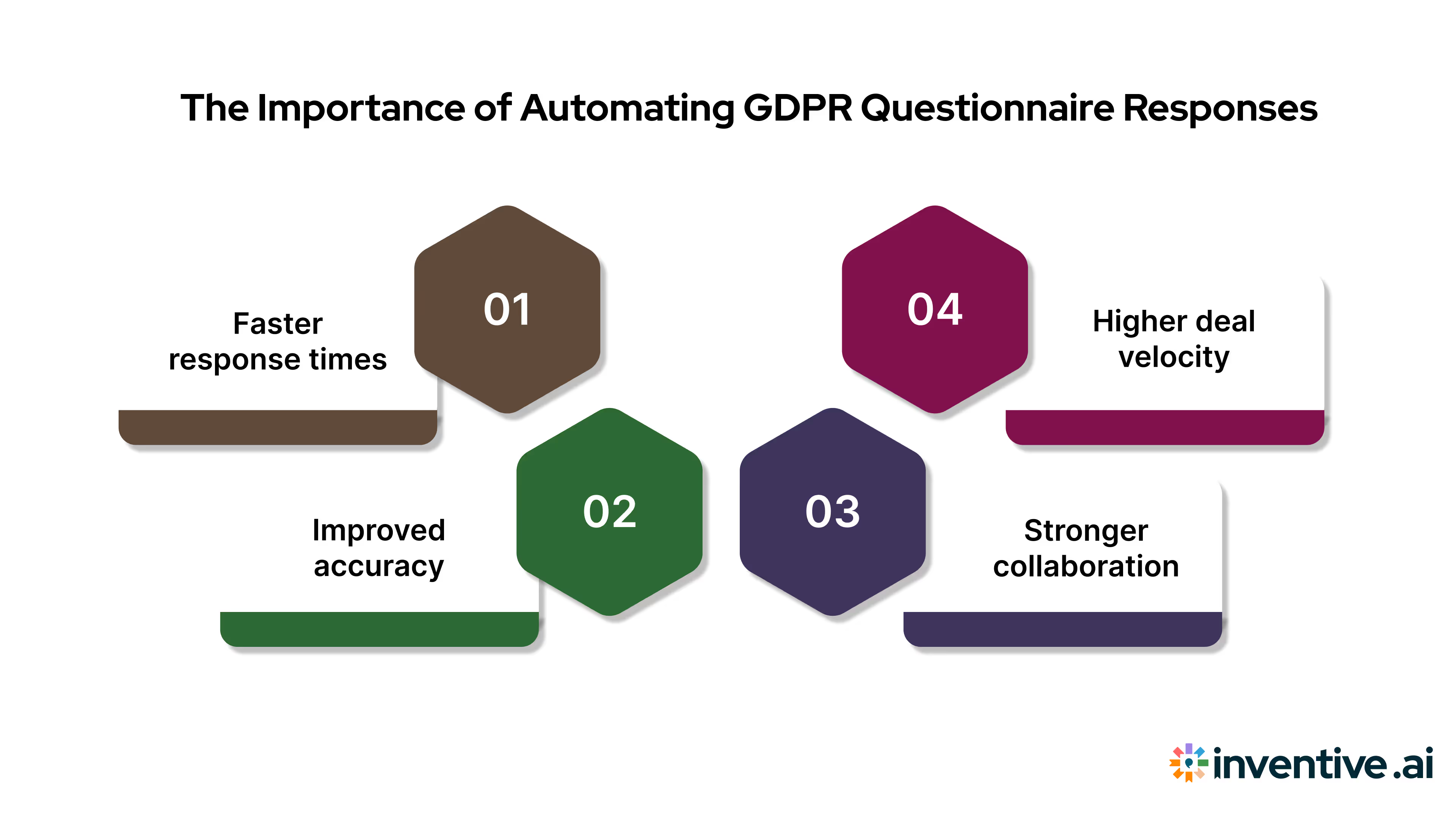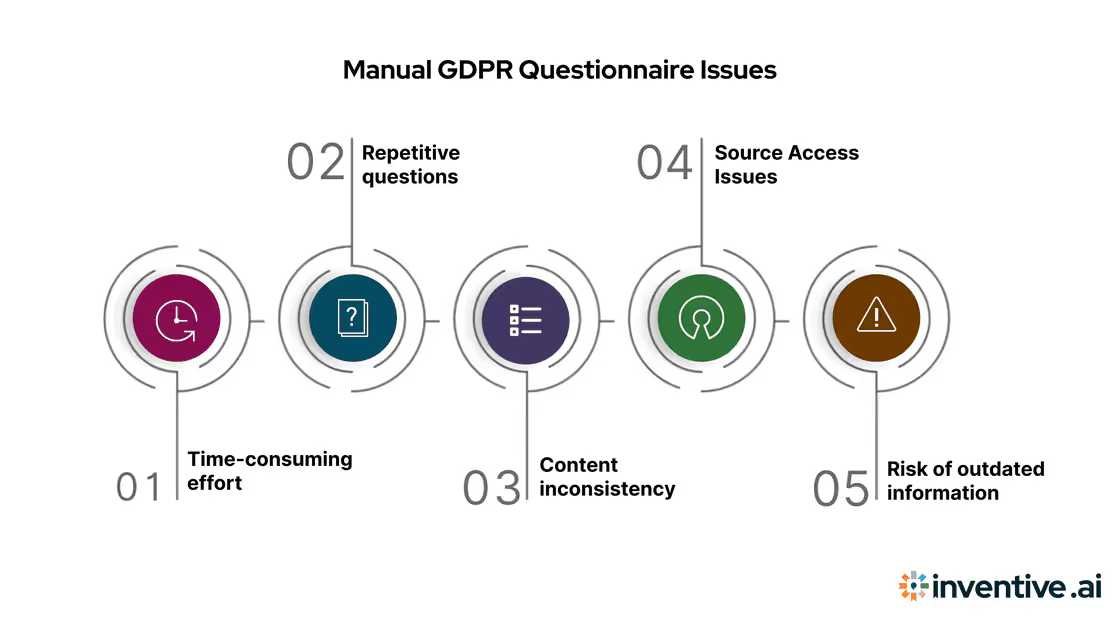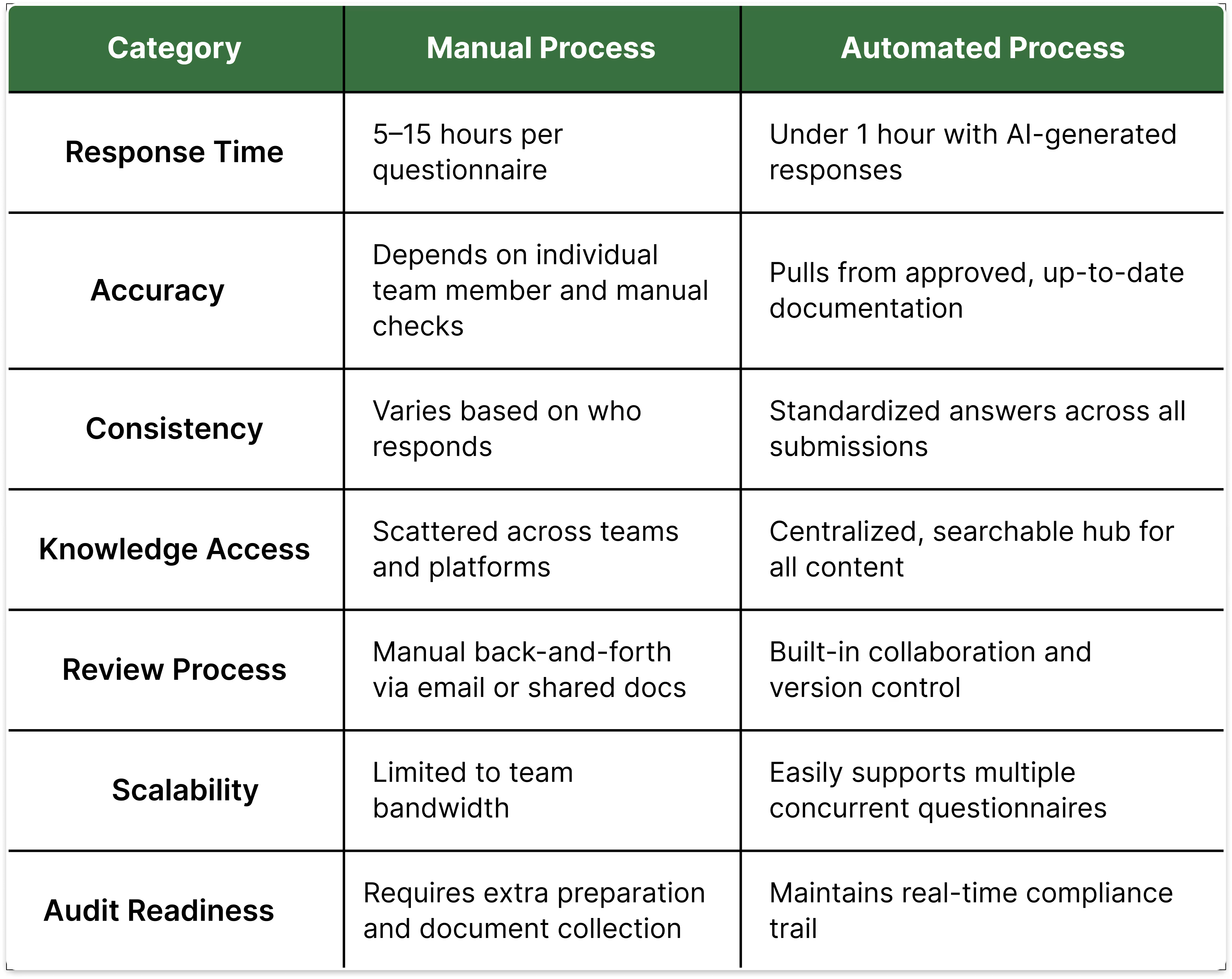GDPR Compliance Guide with Automation Tips
Learn what GDPR questionnaire automation is, how it works, and its step-by-step setup process. Improve turnaround time and ensure better responses every time.

GDPR questionnaires are growing longer, more repetitive, and more critical to deal success. For every vendor review, teams are asked the same questions on data handling, consent tracking, and access control, often under tight timelines.
If you’re still answering these manually, you’re missing out on a faster, more reliable system. In fact, 83% of businesses already consider the use of AI as their main priority. Automation helps remove repetition, avoid conflicting responses, and give every team involved an efficient path from intake to submission.
In this guide, you’ll see exactly how GDPR questionnaire automation works and what steps you can take to set up a structured, repeatable response process.
TL;DR:
- Manual GDPR questionnaires often take hours to complete and require inputs from multiple teams.
- Automation works by centralizing content, auto-generating responses, and routing questions to the right people.
- Outdated or conflicting answers are common without content control and version tracking.
- A unified knowledge base reduces time spent searching for docs and improves consistency.
- Scaling questionnaires becomes possible when repetitive tasks are handled through automation.
What is GDPR Questionnaire Automation?
GDPR questionnaire automation is the process of using software to streamline how companies handle data privacy and compliance questionnaires from prospects, clients, or auditors.
These questionnaires often contain dozens or even hundreds of recurring questions about how a company collects, stores, and secures personal data. Common topics include encryption, consent tracking, data subject rights, and vendor risk management.
Instead of answering these questions from scratch each time, automation tools pull from a centralized knowledge base to auto-fill answers based on previous submissions. They also keep responses consistent, flag outdated information, and reduce the risk of manual errors.
Automation gives proposal teams a faster, more reliable way to complete questionnaires, improving both accuracy and turnaround times. Let’s take a closer look at the importance of automating the GDPR questionnaire response process.
Why Does Automating GDPR Questionnaire Responses Matter?
Responding to GDPR questionnaires is a critical part of the sales and compliance process, especially for B2B SaaS companies dealing with regulated industries like finance, healthcare, and technology. Recent research shows that 81% of sales teams have either already implemented or are testing the use of AI in their workflow.
Manually answering these questionnaires takes time, introduces risk, and slows down revenue cycles. Here’s why automation can transform how your team handles GDPR questionnaires:

- Faster response times: Automation significantly reduces the time needed to complete each questionnaire by pulling from previously approved answers and documentation.
- Improved accuracy: Centralized response libraries reduce the chance of inconsistent or outdated answers, helping teams maintain compliance across submissions.
- Stronger collaboration: Automated platforms give proposal, compliance, and security teams one shared workspace, making it easier to coordinate input and approvals.
- Higher deal velocity: Faster responses lead to quicker trust from buyers and fewer delays in the sales process.
Manual processes slow teams down and expose them to errors and delays. Automating GDPR questionnaire workflows saves time and also strengthens the company’s compliance posture and enables sales teams to move faster without compromising on quality.
The benefits are clear, but understanding how the process actually functions helps you see where automation fits into your existing workflow.
How GDPR Questionnaire Automation Works?
GDPR questionnaires often follow a predictable format. They ask about your data handling, security controls, consent processes, and third-party relationships. Here's how the process works in practice.
- Data Inventory and Mapping
The first step is identifying where personal data lives across your systems. Automation tools can scan data sources to detect personal identifiers (PII), then map how that data flows through internal processes.
For example, if your customer data moves from your CRM to your support system and then to a third-party analytics tool, mapping makes this flow visible and compliant. Automation ensures the record of processing activities (ROPA) stays up to date without manual tracking.
- Consent Management Automation
Consent logs are a common area of friction in GDPR reviews. Automation allows you to track when and how consent was collected, revoked, or updated across all user touchpoints.
For instance, when a user opts out via a website banner or deletes their data from a mobile app, an automated system updates your logs and keeps a timestamped record ready for the next questionnaire.
- Security Questionnaire Centralization
Instead of storing previous responses across scattered documents or folders, automation tools centralize all responses into one searchable hub. This makes it easy to retrieve accurate, pre-approved language for recurring questions.
For example, if you’re asked about your encryption practices, the system can pull the latest approved version of that answer, saving your team time and effort.
- AI-Powered Response Drafting
Using machine learning, automation platforms can generate first drafts of answers based on your past submissions, knowledge base, or uploaded documentation.
If your organization uses SOC 2 controls for data security, AI can auto-generate responses explaining those practices, pulling directly from your previous SOC 2 documentation.
- Third-Party Risk Management
Vendors are often asked about how they manage third-party data processors. Automation simplifies this by maintaining an updated list of vendors, their risk scores, and related compliance documentation.
For instance, if you're asked to provide proof of a sub-processor's GDPR compliance, the system can surface their DPA or ISO certification instantly, without digging through folders.
Now, knowing how automation works is one thing. Setting it up in a way that works for your team is where the impact becomes real.
Step-by-Step Guide to Implementing GDPR Questionnaire Automation

For successfully setting up GDPR questionnaire response automation, you need the right tool. Inventive AI is designed to take the manual grind out of security and GDPR questionnaire responses.
It allows you to centralize knowledge, collaborate in real-time, and generate accurate responses in minutes instead of hours. Here’s how to implement GDPR questionnaire automation using a structured, step-by-step process.
Step 1: Upload Your GDPR Questionnaire
Start by uploading the questionnaire in whatever format you receive it, whether it’s Excel, Word, PDF, or even scanned copies. Inventive AI’s parser reads and structures each question for easy processing, even if they’re nested in complex formats or spread across multiple sheets.
Step 2: Centralize and Sync Knowledge Sources
Next, bring together your existing content and documentation. Upload previous responses, company policies, compliance records, and certifications. Inventive AI integrates with Google Drive, SharePoint, Notion, and other content repositories so everything lives in one central hub.
Step 3: Generate Draft Responses Using AI
Once the content is structured and synced, Inventive AI’s response agent analyzes the questions and pulls relevant answers from your knowledge base. It doesn’t just match keywords, it understands context, ensuring the draft is aligned with the specific requirement of each question.
Step 4: Assign Sections to SMEs and Collaborate
Security questionnaires often require inputs from IT, legal, product, and compliance. With built-in collaboration features, you can assign specific questions to the right stakeholders, set due dates, and track progress from a shared dashboard.
Step 5: Review and Customize Final Responses
Before submission, review all responses. You can refine language, adjust for tone, or add customer-specific details. For instance, if a customer asks for a description of your third-party data processor vetting process, you can tailor your response to include details specific to their industry or risk concerns.
Step 6: Export and Submit
Once responses are finalized, export the entire questionnaire in the required format, whether it’s Word, Excel, or PDF.
This step-by-step setup turns a process that once took multiple hours or even days into a few focused hours.
Now, along with the setup process, it’s also worth looking at specific challenges to understand how automation can fit in your current response processes.
Challenges of Manual GDPR Questionnaire Responses

Manually completing GDPR questionnaires creates a heavy workload for security, compliance, and proposal teams. These documents are long, repetitive, and often arrive with tight turnaround times. Without a system in place, the process slows down sales cycles and introduces unnecessary risk.
Here are the most common challenges teams face with manual GDPR questionnaire handling:
- Time-consuming effort: Each questionnaire can take anywhere from 5 to 15 hours to complete, especially when answers must be reworked or validated across teams.
- Repetitive questions: Many questionnaires ask identical or similar questions around encryption, access controls, data handling, and consent management, leading to duplication of effort.
- Content inconsistency: Without a centralized response library, answers vary between team members, making it difficult to maintain a consistent tone or level of detail.
- Difficulty accessing source material: Important documentation is often scattered across drives, inboxes, and legacy tools, making it hard to locate and reference the correct supporting information.
- Risk of outdated information: Answers pulled from old documents may reflect outdated policies or expired certifications, increasing the risk of compliance issues.
These inefficiencies create bottlenecks that delay deals and affect trust with prospects. For teams managing multiple questionnaires every month, the manual approach is simply not sustainable.
Traditional vs. Automated GDPR Questionnaire Management
Teams still relying on traditional, manual methods to complete GDPR questionnaires face limitations in speed, accuracy, and scale. Automation offers a smarter way to manage this process, especially for organizations handling multiple vendor assessments or RFPs every quarter.
Here’s how manual and automated approaches differ across key areas:

Shifting from manual to automated GDPR questionnaire management allows teams to respond faster, and deliver consistent answers.
However, before teams can fully leverage automated GDPR questionnaire tools, the foundation must be strong. Here are some operational best practices to ensure GDPR answers stay accurate at all times.
Best Practices for Maintaining GDPR Questionnaire Accuracy
Even a well-built automation system is only as good as the data behind it. To ensure trust and compliance, responses must be maintained through ongoing review and operational discipline. These best practices help future-proof your GDPR responses and reduce the risk of outdated or incorrect answers.
- Run quarterly content reviews: Schedule regular audits to check for expired references, policy changes, or outdated regulatory language.
- Keep SMEs aligned and accountable: Establish a recurring process for subject matter experts to review and approve updates, particularly for high-risk content.
- Use consistent naming conventions: Standardize how documents and responses are labeled to avoid duplicates and improve searchability across systems.
- Implement version control protocols: Maintain a clean version history so your team knows what is current, what is outdated, and what is under review.
- Assign clear content ownership: Designate specific team members or roles responsible for managing updates within each content category.
- Add metadata tags to each entry: Tag entries by theme, product, risk level, or compliance area to improve discoverability and future updates.
- Set up change notification workflows: Make sure any updates trigger alerts to relevant teams so nothing is missed in downstream responses.
A few strategic operational best practices go a long way. However, with the right tool, you can further enhance the process.
How Inventive AI Helps Automate GDPR Questionnaire Responses
Security questionnaires often create bottlenecks at the worst time, right when a deal is moving forward. Teams scramble to locate old answers, and ensure nothing slips through. It’s a slow, manual cycle that drains resources and delays revenue.
Inventive AI removes this friction with an automation platform built for accuracy, speed, and control.
Here’s why Inventive AI stands out for GDPR questionnaire automation:
- Confidence-scored, cited responses: Every answer is backed by your internal knowledge base, complete with citations and a confidence score. This gives reviewers clarity on what’s accurate, what needs a second look, and what’s ready to go.
- AI Context Engine with tone control: Inventive draws insights from the questionnaire, the opportunity, past deals, and even meeting notes to generate highly relevant answers. Then, adjust tone, length, or complexity instantly to match the audience or buyer.
- Real-time knowledge syncing: The system pulls and updates content directly from platforms like Google Drive, SharePoint, Confluence, Notion, and CRM systems. You avoid version conflicts and keep every answer aligned with current documentation.
- Conflict detection and resolution: Inventive flags inconsistent or stale responses before they go out the door. It surfaces duplicates, mismatches, or outdated policy language, so teams don’t risk sending conflicting answers to the same prospect.
- Built-in proposal intelligence agents: From win-theme generation to competitor positioning, specialized agents help teams sharpen responses and bring strategic depth to questionnaires that go beyond check-the-box answers.
- Proven impact on workflow performance: Teams using Inventive have seen up to 90% faster RFP and questionnaire completion times, 2.5x more submissions in just three months, and over 50% higher win rates across competitive bids.
Inventive AI is designed to take the weight off your team without losing control of the process. It helps you move faster without cutting corners and makes scaling security responses possible without increasing headcount.
Here’s what our users say:
“Future of RFP/RFI/security questionnaire responses! Saves our team a ton of time.
Lot of great features. User experience is extremely intuitive and the team is very responsive.”
– Ben H (Head of Solutions)
Final Thoughts
GDPR questionnaire automation removes the friction that slows down proposal and security teams during high-stakes deal cycles. Instead of chasing documents or duplicating effort across departments, teams can work from a single, reliable source of truth and respond faster with greater accuracy.
When automation is built with your systems, workflows, and controls in mind, it becomes a strategic lever for speed and consistency. Teams stop losing hours to repetitive work and focus on strategic inputs that actually move deals forward.
Inventive AI gives your team the control, structure, and reliability needed to scale GDPR questionnaire responses without adding more people.
Schedule a demo to see how your team can reduce turnaround time, increase submission volume, and improve win rates.
FAQs
1. How do companies prepare for GDPR questionnaires?
They organize documentation in advance, maintain a central knowledge base, and gather input from legal, IT, and compliance teams. Preparation includes keeping policies updated and aligned with GDPR principles.
2. Can small teams handle GDPR questionnaires efficiently?
Yes, with a documented process and reuse of past responses, even small teams can manage them effectively. Automation tools can further reduce workload by handling repetitive questions.
3. What if different teams give conflicting answers?
Conflicting responses can lead to compliance issues or failed assessments. It's important to standardize responses and use a shared content repository to avoid discrepancies.
4. Are GDPR questionnaires the same across industries?
The core topics are similar, but the depth and technical detail vary by industry and customer expectations. Highly regulated sectors often include more detailed security and legal questions.
5. How often should GDPR questionnaire content be updated?
Review and update content at least quarterly or whenever there’s a change in policy, infrastructure, or regulation. Stale or outdated answers can raise red flags during reviews.


